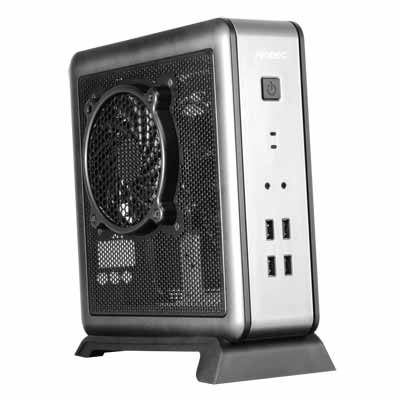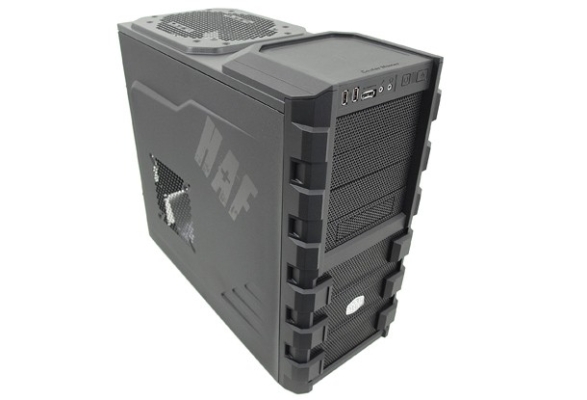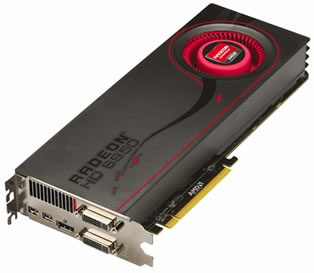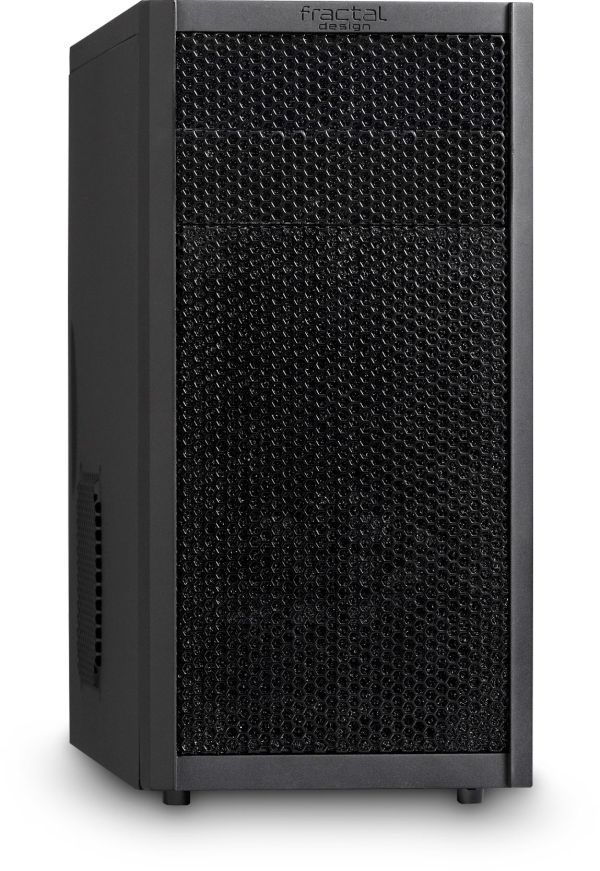Back To School Technology Buyer's Guide
by Zach Throckmorton on August 4, 2011 8:55 PM ESTBuild your own PC
You can usually build a desktop computer for less money than it costs to buy a comparably-specced system from a retailer. The discrepancy generally becomes greater as overall cost and capability go up. Additionally, many college students have access to very low cost Windows 7 licenses. For example, Windows 7 Ultimate costs students here at UW-Madison $64, while at Indiana University it's $20 and at the University of Michigan, $19 (Wolverines can also buy Vista for $9.50—curb your enthusiasm). Be sure to check with your specific college to see if you can get Windows (and other useful software) at a discount before paying retail prices for your OS. Because the cost of the OS varies dramatically from college to college, it is omitted from the following builds.
With that important consideration, let's get to the builds! We present here three configurations: a very tiny but capable mini-ITX system, a relatively small, inexpensive micro-ATX rig, and a more powerful mid-tower. We also suggest upgrades for each computer tailored to different uses.
Intel Mini-ITX System
| Intel Core i3 Sandy Bridge mini-ITX PC | |||||
| Component | Product Name | Cost | |||
| Case + PSU | Antec ISK 100 80W PSU | $85 | |||
| CPU | Intel Core i3-2100T | $135 | |||
| Motherboard | ASUS P8H61-I (Rev. 3.0) | $85 | |||
| Memory | Patriot 4GB (2x2GB) DDR3 SDRAM | $33 | |||
| Hard drive | Samsung Spinpoint MP4 HM320HJ 320GB | $48 | |||
| Total: | $386 | ||||

This mini-ITX system built in an Antec ISK 100 is more than powerful enough to handle web browsing, HD video playback, photo and video editing, many kinds of scientific analysis, and of course, office productivity. It's also sufficiently powerful that you should expect to be able to use it to perform these tasks for your entire four year undergraduate career. Best of all, its tiny case measures less than 9" tall by 9" deep by 4" wide. That's about the size of a hardcover novel (and smaller than an intro biology text!)—saving valuable real estate in a cramped dorm room, for example. Once assembled, it will weigh less than four pounds. It's important to note that the ultra low-profile heatsink that comes with the Core i3-2100T fits inside the ISK 100, but the stock heatsink that comes with the Core i3-2100 does not. Gelid makes a low-profile heatsink that would let you use a Core i3-2100 in the ISK 100 but it is difficult to find. Perhaps its only drawbacks given its size are that it lacks an optical drive and it is not a gaming computer, nor can it be upgraded to become a gaming computer. That said, there is room for two 2.5" hard drives, so you could certainly upgrade it for faster responsivity by adding an SSD or for more storage by adding a more spacious, slower 2.5" mechanical drive.
AMD Micro-ATX System
| AMD Athlon II X3 Micro-ATX PC | ||
| Component | Product Name | Cost |
| Case | Fractal Design Core 1000 | $50 |
| PSU | XIGMATEK ACXTNRP-PC402 400W | $35 |
| CPU | AMD Athlon II X3 445 | $75 |
| Motherboard | Biostar A880G+ | $55 |
| Memory | Patriot 4GB (2x2GB) DDR3 SDRAM | $33 |
| Hard drive | Western Digital WD5000AAKX 500GB | $40 |
| Optical drive | LITE-ON iHAS124-04 | $20 |
| Total: | $298 | |
While the AMD Athlon II X3 445 is slightly less powerful than the Intel Core i3-2100T in the mini-ITX system, it is nevertheless a potent processor up to most tasks, and certainly more than sufficient to provide four years of basic computing. This AMD CPU offers tremendous value—a lot of bang for the buck. Importantly, should you deem more power necessary in a few years, the six core Thuban CPUs will be simple, drop-in upgrades and by then, likely will cost less than $100. That said, the tri-core chip will remain a capable office system processor for four years. For an idea of how it performs, check AnandTech's Bench.
The Fractal Design Core 1000 is one of my favorite newer cases to hit the market. Its low price tag, quality construction, smaller size, and aesthetics are major selling points. At less than 17" deep by 7" wide by 14" tall, it's more compact than many micro-ATX cases, yet large enough to hold many hard drives, a bigger aftermarket CPU heatsink, and/or a larger GPU if you want to upgrade it. I find its thermals are slightly improved by moving the front intake fan to the rear of the case to act as an exhaust.
Biostar's A880G+ is a great value; it's a well-featured budget board that even has an HDMI port, and its integrated Radeon HD 4250 graphics are more than adequate for running Windows' Aero feature and Flash games. Perhaps its only drawback at this price point is its lack of USB 3.0 ports, which will become increasingly useful, though again at this low price, they aren't expected (and a USB 3.0 expansion bracket could be added later if the need arises). Finally, the Xigmatek PC402 400W PSU is relatively well-built for its price tag, and has a quiet 140mm fan.
This system could easily be turned into a respectable gaming rig by adding a discrete video card. Given the thermal limitations of the case at stock, I suggest adding a 120mm fan for better airflow. And given the limitations of the 400W PSU, I wouldn't add a GPU that's more power-hungry than a Radeon HD 6870, and even that would require a molex-PCIe adapter. The Radeon HD 6770 (the rebadged Radeon HD 5770) remains a very strong value for $100 or less after rebate, providing gamers acceptable frame rates or better at resolutions lower than 1080p with medium settings in all but the most demanding games.
Intel Mid-Tower System
| Intel Core i5 Sandy Bridge ATX PC | |||
| Component | Product Name | Cost | Rebate |
| Case | Cooler Master HAF 912 | $75 | -$10 |
| PSU | Antec Earthwatts 430W | $44 | |
| CPU | Intel Core i5-2500K | $220 | |
| CPU heatsink | Cooler Master Hyper 212+ | $30 | |
| Motherboard | Biostar TZ68A+ | $100 | |
| Memory | Patriot 8GB Gamer 2 Series (2x4GB) DDR3 SDRAM | $55 | -$20 |
| Primary storage | OCZ Vertex 2 solid state drive | $100 | |
| Secondary storage | Western Digital 1TB 5400RPM WD10EARS hard drive | $55 | |
| Video card | XFX HD-679X-ZDFC Radeon HD 6790 | $135 | -$15 |
| Optical drive | Samsung SH-222AB | $19 | |
| Total: | $833 | $788 | |

If you have more space than a typical dorm room (or think having a powerful computer is worth being even more cramped than usual in a dorm room), this midtower has all the bases covered. The Cooler Master HAF 912 features excellent thermals (HAF stands for high air flow), integrated mounts for 2.5" SSDs, solid cable management, and it's capacious enough for larger video cards and aftermarket CPU heatsinks. At 20" deep by just over 9" wide by 19" tall and weighing in at 18 pounds, it's probably not going to disappear if you inadvertently leave your room unlocked.
The Intel Core i5-2500K is an extremely potent CPU that will remain a very solid processor for four more years (think of how 2007's Q6600 is still a capable chip). Its performance metrics are available in Bench. The Cooler Master Hyper 212+ is a great value, and should allow you to overclock the CPU to 4GHz with minimal effort, though better chips can hit 4.5GHz and some even approach 5GHz. I've had excellent results from the Biostar motherboard in terms of overclocking, and its low price for a Z68-chipset board with all the bells and whistles makes it a compelling option. Of course, a system like this should have an SSD for overall responsiveness, and the OCZ Vertex 2 is a venerable stalwart at an increasingly low price. The 1TB low RPM hard drive offers plenty of storage, though you could certainly swap it out for a larger, faster (i.e. 7200RPM) hard drive if you'll be installing a lot of games that won't fit on the SSD and will benefit from not being put on a 'green' drive.

Finally, we've opted to recommend a Radeon HD 6790 because of its value, though a GeForce GTX 460 1GB might be worth spending a few dollars more for a bit better performance. If you want to spring for GPUs that will play the latest titles for a year or two longer than these, consider the AMD Radeon HD 6950 and NVIDIA GeForce GTX 560 Ti. These cards trade blows both in terms of performance and are priced at $200 or slightly higher.
While these do it yourself builds cover a range of typical college uses and needs, we recognize that many readers prefer retail, pre-built systems. Therefore a few models are discussed on the next page.











94 Comments
View All Comments
Gigantopithecus - Friday, August 5, 2011 - link
After thinking about this and on the advice of Ryan, our GPU guru, I edited the article to recommend nothing more power-hungry than a 6870. That's a more comfortably conservative recommendation, and I think it's better to err on the side of caution.mariush - Saturday, August 6, 2011 - link
That's indeed better.A lot of the pre-built computers still come with very cheap power supplies based on old designs with lots of amps on 3.3v and 5v and not so much on 12v, so those 220 watts could be a bit too much for these power supplies.
Someone might get mixed up and think that any kind of 400w power supply would be capable of this, which is of course not true.
Hrel - Thursday, August 4, 2011 - link
I would like to add a set I've had some personal experience with that are excellent. Sound is crystal clear, I'm not kidding. NO distortion even at max volume! Satisfying Bass.http://www.amazon.com/Onkyo-HTX-22HDX-Ultra-Compac...
It's got a 1% THD rating, so you can believe me when I say there really is no distortion. The bass isn't quite as good as those klipsch, which I've also used. But it is full and satisfying for 90-99% of uses. Not quite as penetrating as the Klipsch so your neighbors will thank you. Also doesn't get quite as loud as those Klipsch, but more than loud enough for realistic uses. Especially in a dorm/apartment. Has a night time mode that's actually usefull and many settings. And unlike all the other systems you linked it has a full receiver built into it. Full HDMI support and all the hookups you could ever want. That way you can get your game system and pc and laptop all running through it. With a remote so you don't have to get up every time you want to change devices. On top of that it supports 3 more speakers than the ones included so you could have a full 5.1 surround sound set up down the road if you chose to. Maybe after college, or once you get a bigger apartment or house or something. I often find them on newegg for 250 or less. Right now they're 230 on amazon. Really amazing deal for everything you get. Chintzy controller, but at this price all that matters is it works, and it does. If that matters to you get a Logitech universal remote.
Personally I use this when I want music streaming from my computer but I'm playing a game online over xbox. I don't really care about the explosion sounds of the game, but I need to visuals going to the tv. But I can have the sound coming from the computer without ever getting up or moving any cables. Pretty convenient and very fairly priced for everything you're getting.
If you're building a dedicated home theatre room you need to spend more; period. But if you don't want to spend more than 250 or so. Or you have limited space or don't want to fuss with cables or just want quality sound and bass without too much hassle or money; that's what these are for. The only other option I think is the Klipsch, which have slightly superior sound but have no receiver, and don't even have optical audio. That last one was a bid deal to me; too much distortion over RCA. I think the Onkyo offering a full receiver with every connection you could ever want, remote, 2 quality speakers with a good sub-woofer and the option to go 5.1 surround sound later more than makes up for the "just slightly" inferior sound. I mean, honestly unless you're completely OCD about sound like I am, you probably won't even notice a difference. Anyway, I think they're a great set of speakers and wanted to spread the word where the word just might be listened to, and appreciated.
Chinoman - Friday, August 5, 2011 - link
I agree with getting a system which has a low-powered sub for decreased penetration. As a current college student, it seems to me that a lot of kids who move on campus don't realize that their 10" subwoofers can be heard just as well on the other side of the wall.Leave the "loud music" to the clubs, don't bring it to the dorms where people next door might be trying to sleep or study.
Zoomer - Friday, August 5, 2011 - link
I would recommend picking up a cheap but decent receiver from craigslist for $50++ and using that. It just needs to do at least 2 channels (or 5), and there are many receivers out there that are good quality, but doesn't support hdmi switching or what not. It's not really necessary anyway. Save the money for the speakers; you'll find that HDMI switching, crazy fancy features and what not doesn't matter as much as the speakers.Roland00Address - Thursday, August 4, 2011 - link
They were planning to but they removed it before it was released (May of 09 they removed the 3 app limit, windows 7 starter like the rest of windows 7 was released to oems in July of 09 and to the general public in Oct of 09.)Gigantopithecus - Thursday, August 4, 2011 - link
Thanks Roland! Edited the article accordingly after confirming with a friend who just got the 1001P. The first thing I do when I buy a new machine (or as happens more often, a friend brings me their new machine) is install one of those heavily discounted W7 Ultimate licenses. Admittedly I have little experience with W7 Starter. ;)Roland00Address - Friday, August 5, 2011 - link
If you are a student and you can get W7 Ultimate or W7 Pro for cheap through your campus book store, then you will want to hop onto it.W7 Premium, Pro, and Ultimate add back the Windows 7 Media Center functionality.
W7 Pro and Ultimate add the remote desktop so you can log back on in your Desktop at the Dorm and grab the file you forgot to save, and have it sent back to your netbook.
Zoomer - Friday, August 5, 2011 - link
Or Pro for free through MSDNAA.johnnywa - Friday, August 5, 2011 - link
I find it wrong to assume that you can't get a desktop-like experience out of a laptop, but the article does seem to reinforce this notion. With a laptop, you can still purchase a monitor (or small TV), keyboard, and mouse, and you can end up with essentially a desktop that you can unhook and take around with you when you need to. I tried this solution for the last 2 years (minus monitor, although sometimes I hooked my lappy up to our apartment's 37" TV), and it was a very comfortable setup. Of course this isn't an end-all-be-all solution, but I'd say it's another alternative to desktop + netbook.